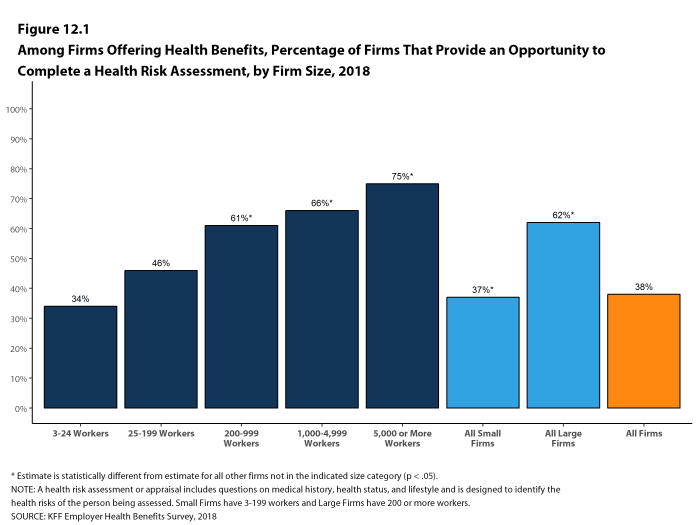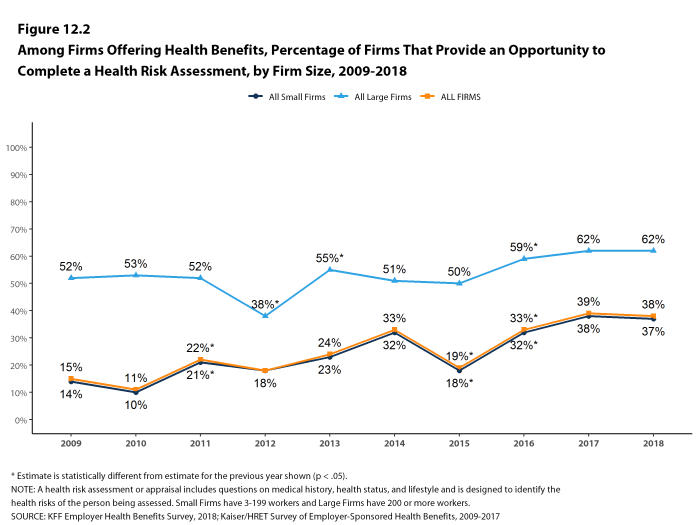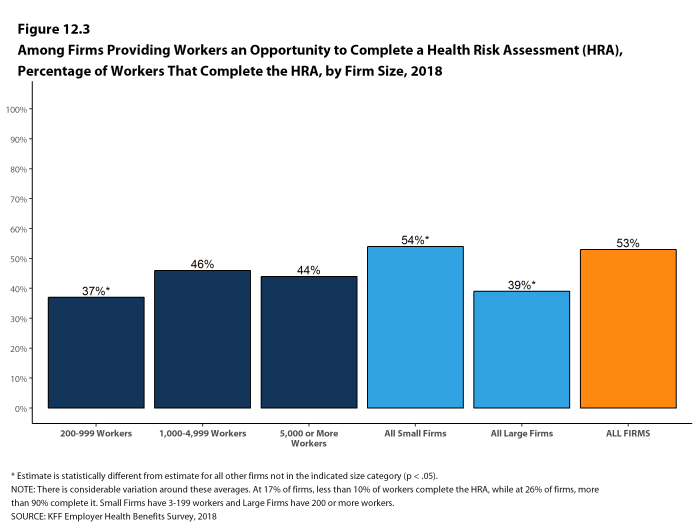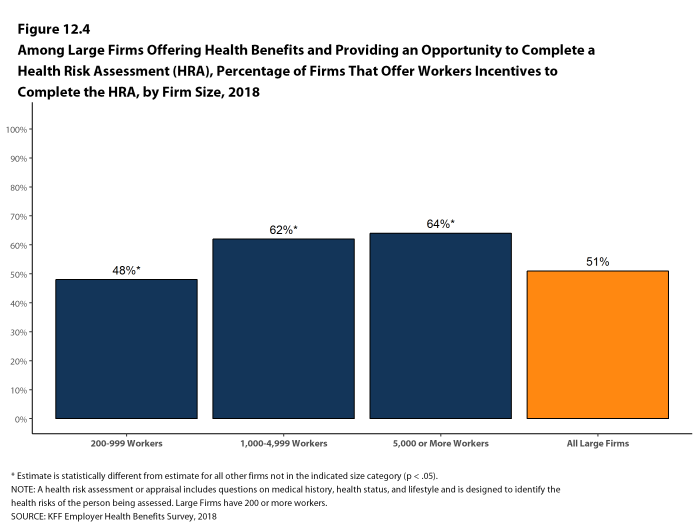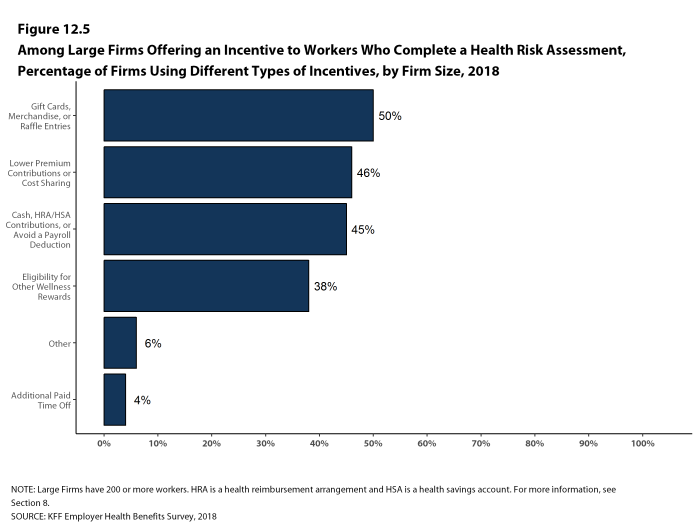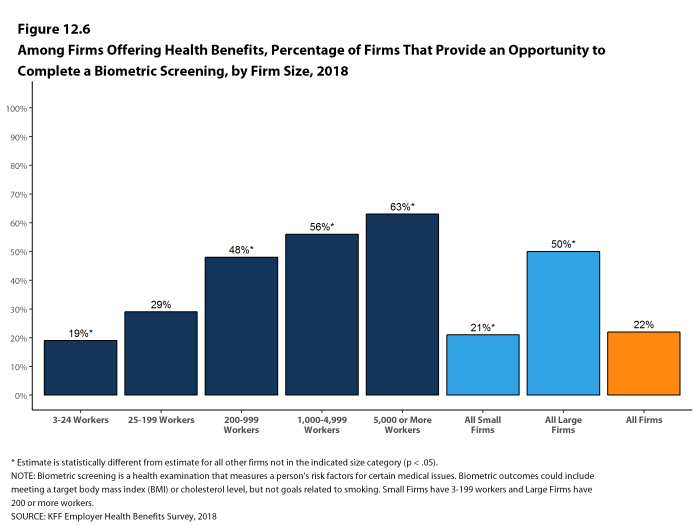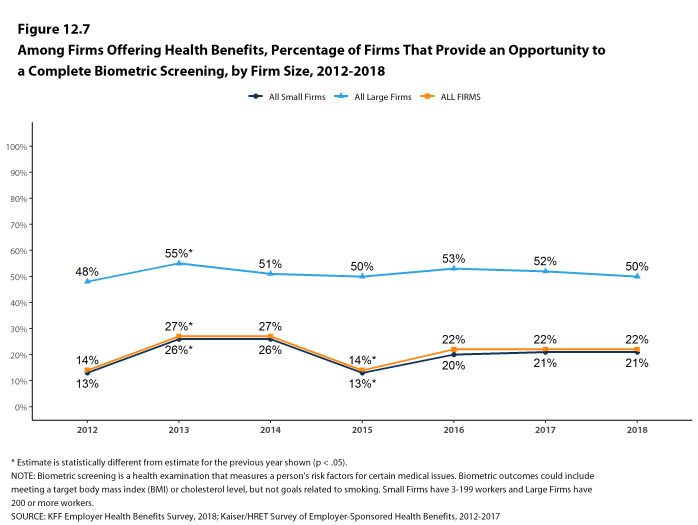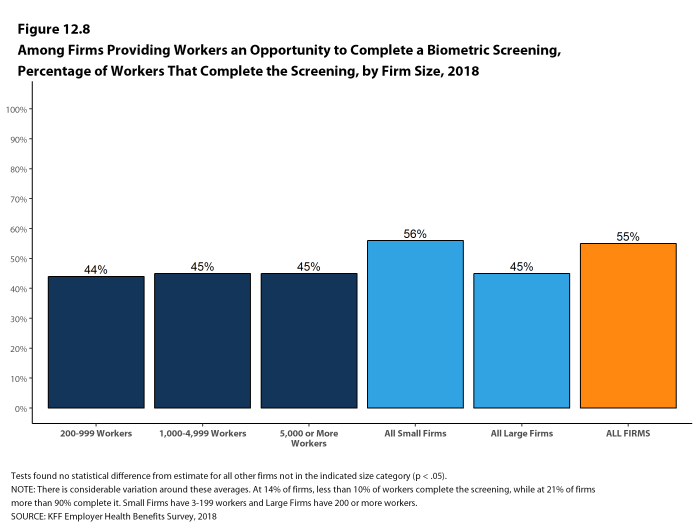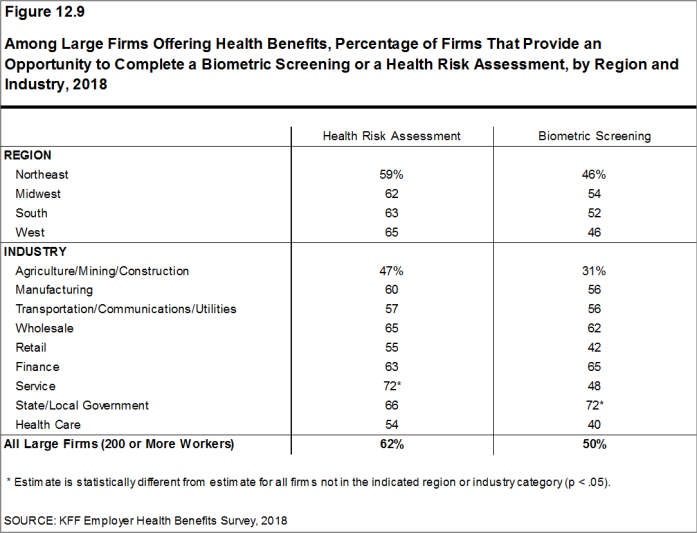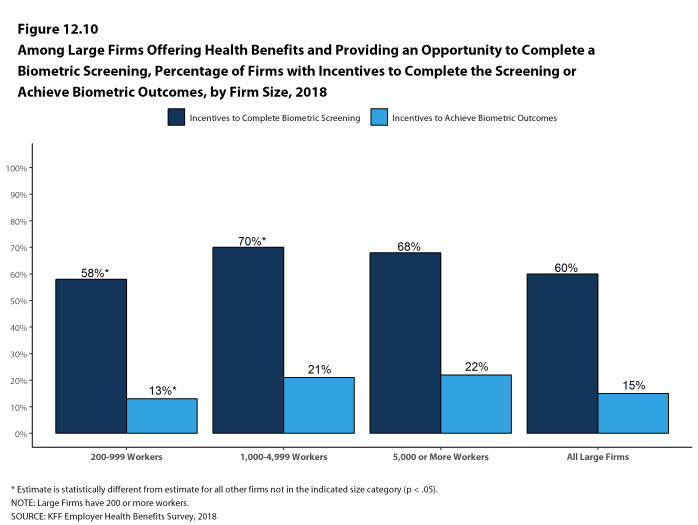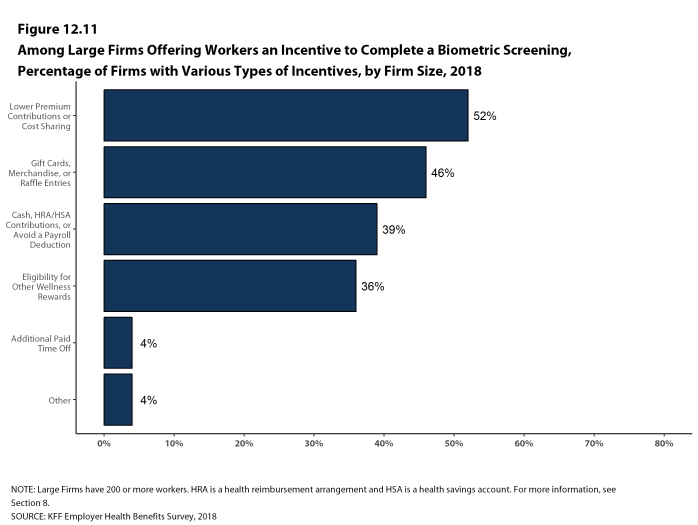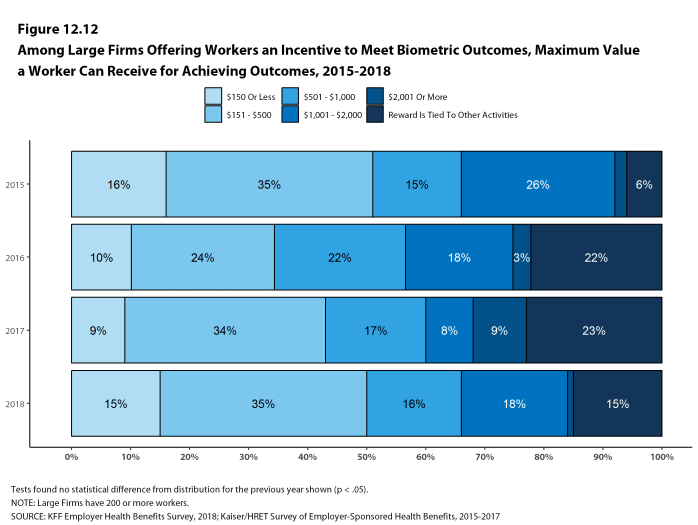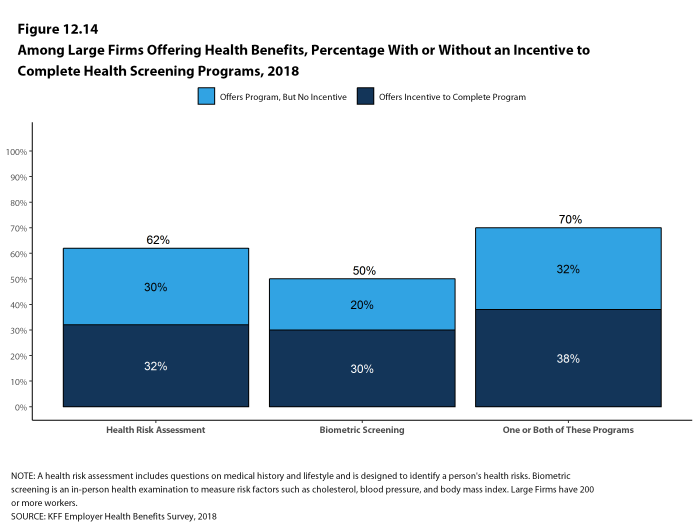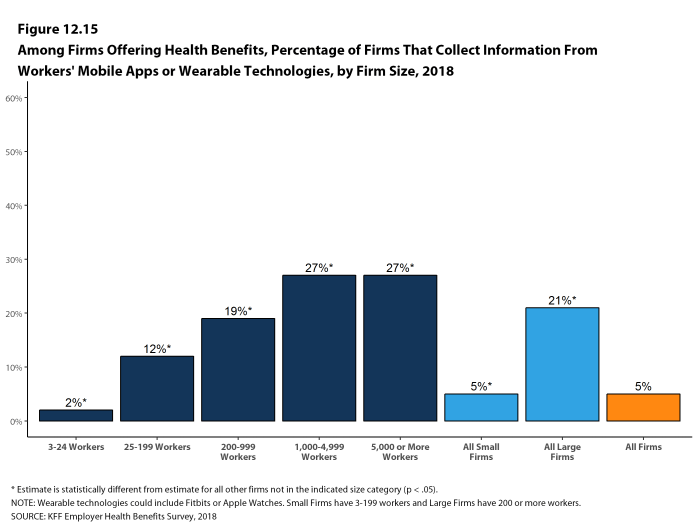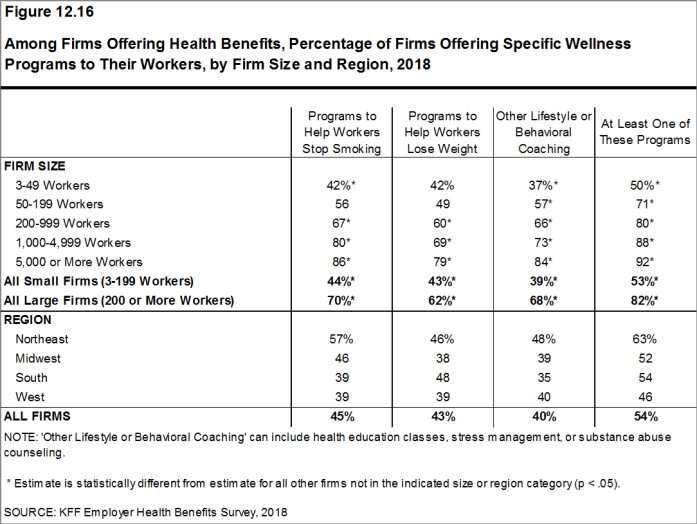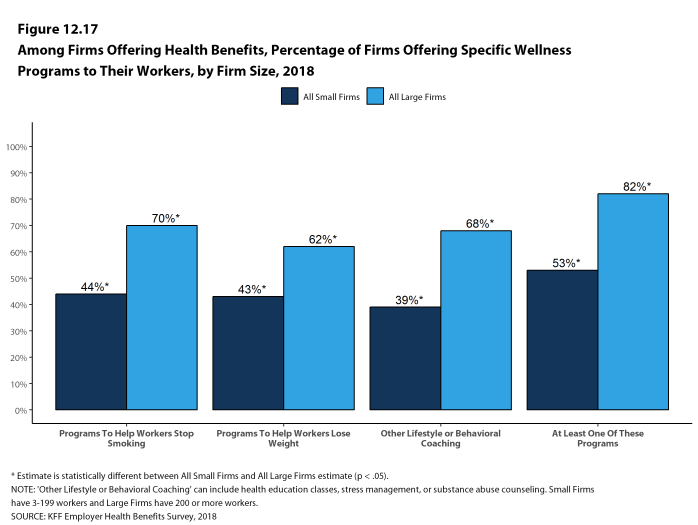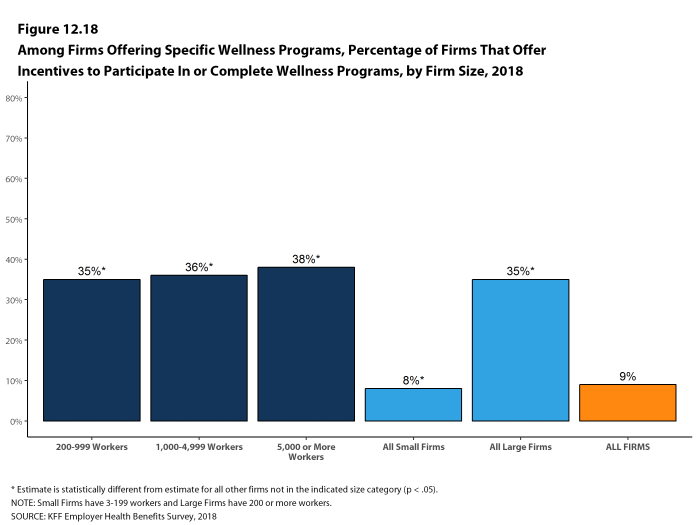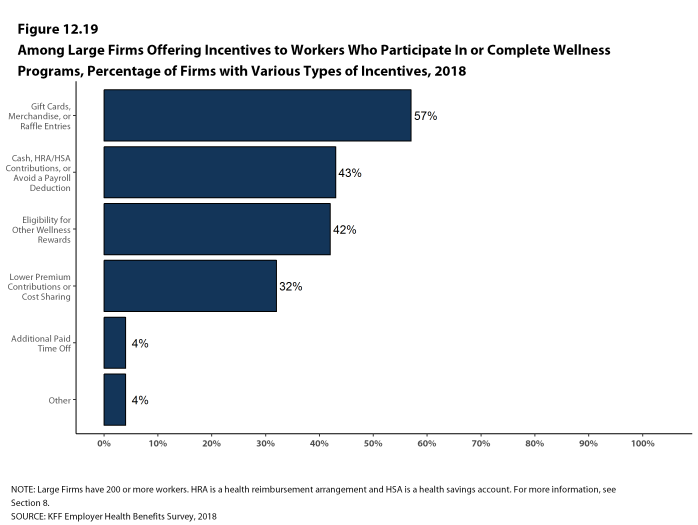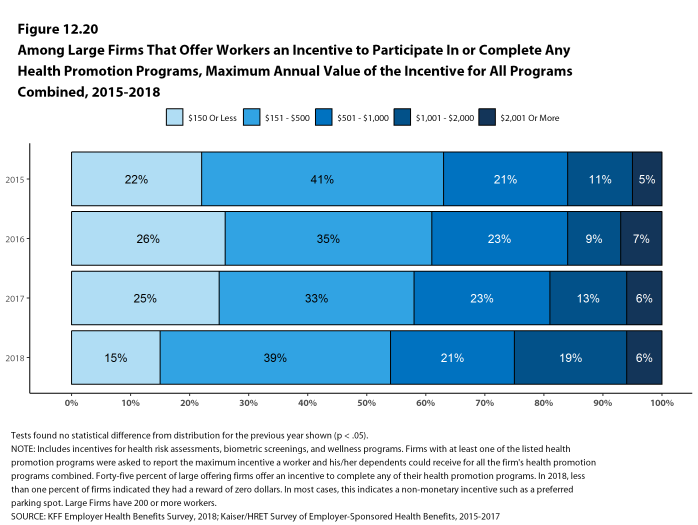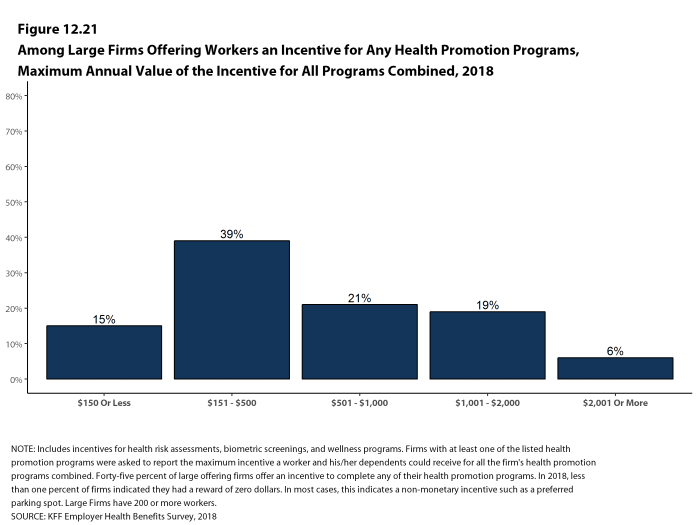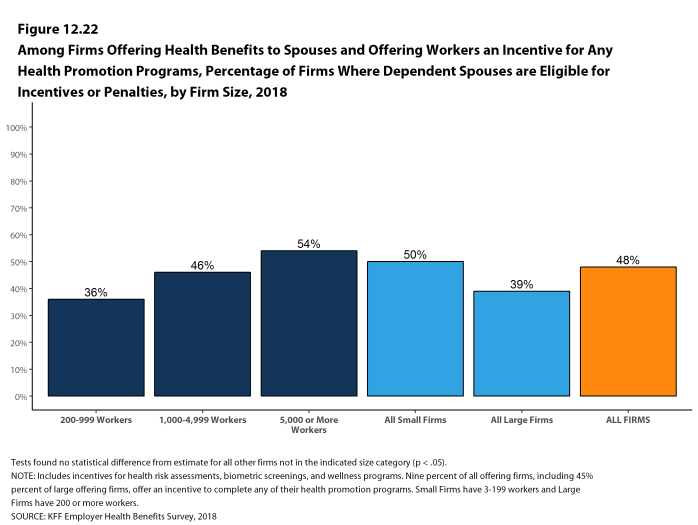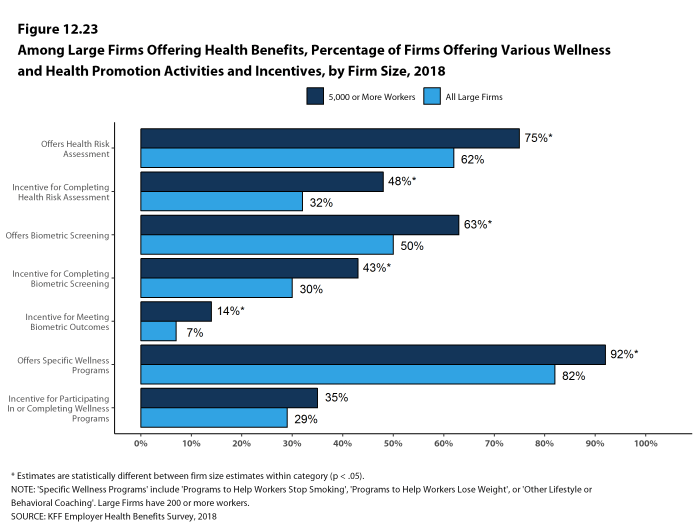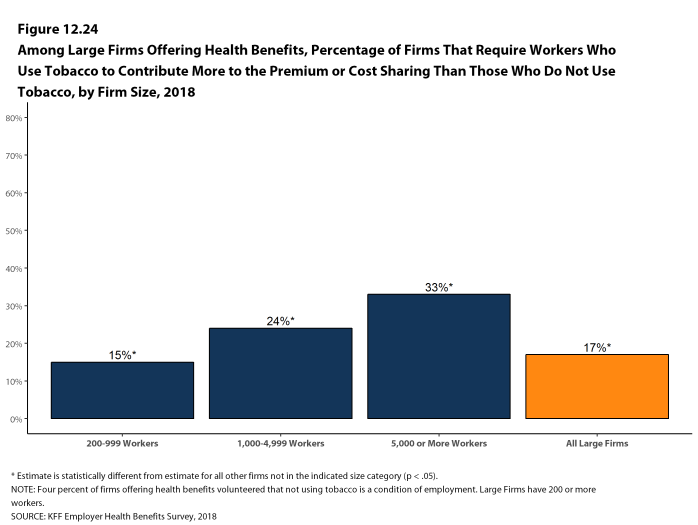2018 Employer Health Benefits Survey
Section 12: Health and Wellness Programs
Firms continue to show considerable interest in programs that help workers identify health issues and manage chronic conditions. Many employers believe that improving the health of their workers and their family members can improve morale and productivity, and reduce health care costs.
In addition to offering wellness programs, a majority of large firms now offer health screening programs, including health risk assessments, which are questionnaires asking workers about lifestyle, stress, or physical health, and biometric screening, which we define as in-person health examinations conducted by a medical professional. Firms and insurers may use the health information collected during screenings to target wellness offerings or other health services to workers with certain conditions or behaviors that pose a risk to their health. Some firms have incentive programs that reward or penalize workers for different activities, including participating in wellness programs or completing health screenings.
Only firms offering health benefits were asked about their wellness and health promotion programs. Information about incentives is reported only for large firms (200 or more workers) because there is a relatively high degree of uncertainty among small firm (3-199 workers) respondents.
Among large firms offering health benefits in 2018, 62% offer workers the opportunity to complete a health risk assessment, 50% offer workers the opportunity to complete a biometric screening, and 82% offer workers wellness programs, such as programs to help them stop smoking or lose weight, or programs that offer lifestyle and behavioral coaching. Substantial shares of these large firms provide incentives for workers to participate in or complete the programs.
HEALTH RISK ASSESSMENTS
Some firms provide workers the opportunity to complete a health risk assessment to identify potential health issues. Health risk assessments generally include questions about medical history, health status, and lifestyle. At small firms, health risk assessments are typically administered by an insurer.
- Among firms offering health benefits, 37% of small firms and 62% of large firms provide workers the opportunity to complete a health risk assessment [Figure 12.1]. These percentages are similar to the corresponding percentages for 2017 (38% for small firms and 62% for large firms) [Figure 12.2].
- Seventy-five percent of firms offering health benefits with 5,000 or more workers provide workers the opportunity to complete a health risk assessment, similar to the percentage in 2017 (78%) [Figure 12.1].
- Some firms offer incentives to encourage workers to complete a health risk assessment.
- Among large firms that offer a health risk assessment, 51% offer workers an incentive to complete the assessment [Figure 12.4].
- Among large firms offering workers incentives to complete a health risk assessment, 46% reduce premium contributions or cost sharing and 45% offer cash, HSA or HRA contributions, or allow the worker to avoid a payroll deduction [Figure 12.5]. In some firms, workers must complete the assessment to be eligible for other rewards under the firm’s wellness programs. Some firms offer workers more than one type of incentive.
- In firms providing workers the opportunity to complete a health risk assessment, 53% of covered workers complete an assessment, similar to the percentage in 2017 [Figure 12.3].
- There is considerable variation across firms in the percentage of workers that complete the assessment. Sixteen percent of large firms providing workers the opportunity to complete a health risk assessment report that more than 75% of their workers complete the assessment, while 47% report no more than 25% of workers complete the assessment.
- Large firms offering workers an incentive to complete a health risk assessment report a higher share of workers completing the assessment than large firms without an incentive (51% vs. 26%).
Figure 12.1: Among Firms Offering Health Benefits, Percentage of Firms That Provide an Opportunity to Complete a Health Risk Assessment, by Firm Size, 2018
Figure 12.2: Among Firms Offering Health Benefits, Percentage of Firms That Provide an Opportunity to Complete a Health Risk Assessment, by Firm Size, 2009-2018
Figure 12.3: Among Firms Providing Workers an Opportunity to Complete a Health Risk Assessment (HRA), Percentage of Workers That Complete the HRA, by Firm Size, 2018
Figure 12.4: Among Large Firms Offering Health Benefits and Providing an Opportunity to Complete a Health Risk Assessment (HRA), Percentage of Firms That Offer Workers Incentives to Complete the HRA, by Firm Size, 2018
BIOMETRIC SCREENING
Biometric screening is a health examination that measures a person’s risk factors (such as cholesterol, blood pressure, and body mass index (BMI)) for certain medical issues. A biometric outcome involves assessing whether the person meets specified health targets related to certain risk factors, such as meeting a target BMI or cholesterol level. As defined by this survey, goals related to smoking are not included in the biometric screening questions.
- Among firms offering health benefits, 21% of small firms and 50% of large firms provide workers the opportunity to complete a biometric screening [Figure 12.6]. These percentages are similar to 2017 (21% and 52%) [Figure 12.7].
- Some firms offer incentives to encourage workers to complete the biometric screening.
- Among large firms with biometric screening programs, 60% offer workers an incentive to complete the screening [Figure 12.10]. Some firms report offering more than one type of incentive.
- Among large firms with an incentive for workers to complete a biometric screening, 52% reduce premium contributions or cost sharing and 39% offer cash, HRA or HSA contributions, or allow the worker to avoid a payroll deduction. As with incentives for health risk assessments, workers in some firms must complete the biometric screening to be eligible for other rewards under the firm’s wellness programs [Figure 12.11].
- In firms providing workers the opportunity to complete a biometric screening, 55% of covered workers complete a screening [Figure 12.8].
- There is considerable variation across firms in the percentage of workers who complete a biometric screening. Twenty-one percent of large firms providing workers the opportunity to complete a biometric screening report that more than 75% of their workers complete the screening, while 40% report no more than 25% of workers complete the screening.
- Large firms offering an incentive for workers to complete a biometric screening report a higher share of workers completing the screening than large firms without an incentive (54% vs. 30%).
- In addition to incentives for completing a biometric screening, some firms offer workers incentives to meet biometric outcomes. Among large firms with biometric screening programs, 15% reward or penalize workers based on achieving specified biometric outcomes (such as meeting a target BMI) [Figure 12.10].
- The size of the incentives firms offer for meeting biometric outcomes varies considerably. Among large firms offering a reward or penalty for meeting biometric outcomes, the maximum reward is valued at $150 or less for 15% of firms and more than $1,000 for 19% of firms [Figure 12.12]. Fifteen percent of these firms combine the reward with incentives for other activities.
Figure 12.6: Among Firms Offering Health Benefits, Percentage of Firms That Provide an Opportunity to Complete a Biometric Screening, by Firm Size, 2018
Figure 12.7: Among Firms Offering Health Benefits, Percentage of Firms That Provide an Opportunity to a Complete Biometric Screening, by Firm Size, 2012-2018
Figure 12.8: Among Firms Providing Workers an Opportunity to Complete a Biometric Screening, Percentage of Workers That Complete the Screening, by Firm Size, 2018
Figure 12.9: Among Large Firms Offering Health Benefits, Percentage of Firms That Provide an Opportunity to Complete a Biometric Screening or a Health Risk Assessment, by Region and Industry, 2018
Figure 12.10: Among Large Firms Offering Health Benefits and Providing an Opportunity to Complete a Biometric Screening, Percentage of Firms With Incentives to Complete the Screening or Achieve Biometric Outcomes, by Firm Size, 2018
Figure 12.11: Among Large Firms Offering Workers an Incentive to Complete a Biometric Screening, Percentage of Firms With Various Types of Incentives, by Firm Size, 2018
Figure 12.12: Among Large Firms Offering Workers an Incentive to Meet Biometric Outcomes, Maximum Value a Worker Can Receive for Achieving Outcomes, 2015-2018
USE OF HEALTH SCREENING INFORMATION
Among firms offering health benefits, 42% of small firms and 70% of large firms offer workers a health risk assessment, biometric screening or both screening programs.
- Thirty-eight percent of large firms offering health benefits have an incentive for workers to complete a biometric screening or health risk assessment [Figure 12.14].
- Firms with screening programs report using the information from the program for a variety of reasons. Among large firms with a screening program, 62% report using information from their screening programs to target health promotion programs or communications, 53% use information to design new programs, 43% use information to measure health plan costs, 67% use information to understand employee health risks, and 24% use information as the basis for an incentive program [Figure 12.13].
- Among all firms offering health benefits, 5% of small firms and 21% of large firms collect information from workers’ mobile apps or wearable devices, such as a Fitbit or Apple Watch, as part of their wellness or health promotion program [Figure 12.15].
- The percentage of large firms that collect information from workers’ mobile apps or wearable devices has increased from 14% in 2017 to 21% this year.
Figure 12.13: Among Large Firms That Offer a Health Screening Program, How Firm Uses Information Collected, 2018
Figure 12.14: Among Large Firms Offering Health Benefits, Percentage With or Without an Incentive to Complete the Programs, 2018
WELLNESS AND HEALTH PROMOTION PROGRAMS
Many firms and health plans offer programs to help workers engage in healthy lifestyles and reduce health risks. Wellness and health promotion programs may include exercise programs, health education classes, and stress-management counseling. These programs may be offered directly by the firm, an insurer, or a third-party contractor.
- Among firms offering health benefits, 44% of small firms and 70% of large firms offer programs to help workers stop smoking or using tobacco, 43% of small firms and 62% of large firms offer programs to help workers lose weight, and 39% of small firms and 68% of large firms offer some other lifestyle or behavioral coaching program. Fifty-three percent of small firms and 82% of large firms offering health benefits offer at least one of these three programs [Figures 12.16 and 12.17].
- To encourage participation in wellness programs, firms may offer incentives to workers who participate in or complete them.
- Thirty-five percent of large firms offering one of these wellness or health promotion programs offer an incentive to encourage workers to participate in or complete the programs [Figure 12.18]
- Among large firms offering incentives to workers to participate in or complete wellness or health promotion programs, 32% reduce premium contributions or cost sharing and 43% offer cash, HSA or HRA contributions, or allow the worker to avoid a payroll deduction [Figure 12.19].
- Firms with incentives for health risk assessments, biometric screenings, or wellness or health promotion programs were asked to report the maximum reward or penalty a worker could earn for all of the firm’s health promotion activities combined. Some firms do not offer incentives for individual activities, but offer rewards to workers who complete a variety of activities.30 Among large firms offering incentives for any of these programs, the maximum value for all wellness-related incentives is $150 or less in 15% of firms and more than $1,000 in 24% of firms [Figure 12.20].
- Among large firms with incentives for a screening or wellness or health promotion program, 39% make dependent spouses eligible for incentives or penalties under at least one of their programs [Figure 12.22].
Figure 12.16: Among Firms Offering Health Benefits, Percentage of Firms Offering Specific Wellness Programs to Their Workers, by Firm Size and Region, 2018
Figure 12.17: Among Firms Offering Health Benefits, Percentage of Firms Offering Specific Wellness Programs to Their Workers, by Firm Size, 2018
Figure 12.18: Among Firms Offering Specific Wellness Programs, Percentage of Firms That Offer Incentives to Participate In or Complete Wellness Programs, by Firm Size, 2018
Figure 12.19: Among Large Firms Offering Incentives to Workers Who Participate In or Complete Wellness Programs, Percentage of Firms With Various Types of Incentives, 2018
Figure 12.20: Among Large Firms That Offer Workers an Incentive to Participate In or Complete Any Health Promotion Programs, Maximum Annual Value of the Incentive for All Programs Combined, 2015-2018
Figure 12.21: Among Large Firms Offering Workers an Incentive for Any Health Promotion Programs, Maximum Annual Value of the Incentive for All Programs Combined, 2018
Figure 12.22: Among Firms Offering Health Benefits to Spouses and Offering Workers an Incentive for Any Health Promotion Programs, Percentage of Firms Where Dependent Spouses Are Eligible for Incentives or Penalties, by Firm Size, 2018
PENALTIES FOR TOBACCO USE
- Among large firms offering health benefits, 17% of large firms, including 33% of firms with 5,000 or more workers, require higher premium contributions or cost sharing from workers who use tobacco [Figure 12.24]. Some firms noted that not using tobacco is a condition of employment.
- In 2018, less than one percent of firms indicated that they had an incentive for completing health risk assessments, biometric screenings, or wellness or health promotion programs, but had a maximum incentive of zero dollars. These firms may have non-monetary incentives such as preferred parking spots or employee recognition programs.↩

